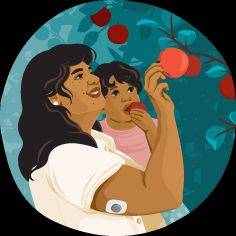When you have ulcerative colitis (UC), eating certain foods can worsen symptoms. Planning meals can help support a balanced diet and ease symptoms during a flare-up.
UC is a type of inflammatory bowel disease (IBD) that affects about
Relapses, also called flare-ups or exacerbations, involve increased inflammation. This can cause symptoms such as abdominal pain, rectal bleeding, and diarrhea.
While there’s no specific diet for UC, research suggests that certain dietary changes may improve symptoms and overall quality of life.
Dana Hunnes, PhD, RD, MPH, is a clinical dietitian at UCLA Medical Center and adjunct assistant professor of community health sciences at UCLA Fielding School of Public Health. During a UC flare-up, Hunnes recommends eating small, frequent meals and snacks.
“Bland foods that are also low in roughage are often easier to digest and absorb during UC flares, making them good options,” Hunnes said. “Spicy foods are not a good idea, as they can hurt on the way out. High fiber foods can exacerbate the flare as well.”
It’s important to have a healthy, varied diet. There’s no one single diet plan that can improve symptoms for everyone with UC.
Consider keeping a food diary to figure out which foods you tolerate well and which tend to worsen symptoms. Hunnes shares some simple UC-friendly dinner ideas.
Bake, boil, or broil a sweet potato and serve it with tender, grilled chicken breast. Feel free to use a yam in place of a sweet potato. Good alternatives to grilled chicken are turkey breast, eggs, or grilled tofu.
What makes it good
Sweet potatoes are root vegetables packed with macro- and micronutrients. Among their many health benefits, sweet potatoes have antioxidant and anti-inflammatory properties.
UC inflammation increases the need for protein. However, eating a lot of protein-rich foods like red meat too frequently can increase inflammation. Chicken, turkey, eggs, and tofu are all lean proteins that can help your body heal and support healthy muscles.
When you’re looking for lighter and quicker fare, try dairy or plant-based yogurt with banana and nut butter (sunflower, cashew, almond, or peanut). Alternatively, you can make quick oatmeal with smooth nut butter and a bit of honey or syrup.
What makes it good
Yogurt provides calcium and is a good way to include probiotics into your diet.
In a 2023 systematic review, researchers found that probiotics can help ease UC disease activity.
Compared with many other fruits, bananas are low in fiber, making them easier to digest. They’re also a great source of potassium, vitamin B6, and other important nutrients.
If your doctor recommends reducing whole grains, choose pasta made with enriched white flour and cook according to package directions.
Hunnes suggests using a blended sauce that’s not too spicy or acidic. Or you can sauté pasta in olive oil with salt, pepper, garlic, or other flavorings. Alternatively, you can top with veggies such as peas or mushrooms and proteins such as chicken or shrimp.
What makes it good
White pasta can help lower your fiber intake during a flare-up.
Adding soft veggies and lean proteins can also help support overall nutrition. The unique versatility of pasta means you can whip it up in a flash or get creative and bring out your inner chef.
A soup and sandwich meal is simple and classic. Add cooked chicken and noodles to vegetable stock with skinless white or sweet potatoes, carrots, and asparagus tips. During a flare-up, stick to seedless, noncruciferous vegetables. Soup can also be puréed or blended.
For the sandwich, choose enriched white or sourdough bread. Try tuna, chicken, or turkey. Consider adding mayo, black pepper, and cucumber slices. Alternatively, you can try a nut butter and jam or sliced banana sandwich.
What makes it good
It’s comfort food with endless variety. Plus, it combines proteins and a choice of many nutritious and easy-to-digest vegetables.
Red and processed meats are associated with increased inflammation, making tuna, chicken, and turkey the better options.
If you like breakfast for dinner, it’s hard to beat eggs and toast. Pair scrambled or hard-boiled eggs with sourdough or white toast. If it doesn’t bother your UC, you can use wheat toast without seeds. Spread toast with butter, jam, or hummus. If you prefer, substitute tofu for eggs.
What makes it good
Either eggs or tofu can help you get that much-needed protein. Starchy foods like white bread can help regain any weight lost during a bad flare-up.
Plus, fortified breads can help provide essential nutrients. This meal can also help satisfy hunger.
Grill or broil salmon and serve with white rice and tender green beans. Feel free to substitute tuna, mackerel, or herring for salmon.
What makes it good
Salmon and other fatty fish are rich in omega-3 fatty acids, which support many bodily functions and may decrease inflammation. The body doesn’t produce enough omega-3 fatty acids on its own, so you have to get them from food.
White rice doesn’t have as much fiber as brown or wild rice, and well-cooked green beans are typically fine to eat during a flare-up.
There’s no one-size-fits-all diet for people with UC. And unless your doctor advises it, there’s no need to restrict meal choices severely. It’s important to your overall health to eat a variety of nutritious foods while avoiding known triggers.
Keeping a food diary can help identify triggers and which foods you can tolerate. Stock up on tolerable foods and try to plan meals in advance instead of waiting until you’re hungry.
If you continue to have dietary concerns, ask your doctor or a registered dietitian for help planning UC-friendly meals.










